![]()
![]()
![]()
Use LEFT and RIGHT arrow keys to navigate between flashcards;
Use UP and DOWN arrow keys to flip the card;
H to show hint;
A reads text to speech;
51 Cards in this Set
- Front
- Back
- 3rd side (hint)

|
Barred Sand Bass (BSB) Paralabrax nebulifer DISTINGUISHING FEATURES: Dark gray to green body with faint crossbars and darker blotches on the side; white ventrally. The third dorsal spine is the longest. RCCA Notes: Look for two bars with a “shoot me here” target spot in the middle. SIZE: up to 26 in (66 cm) in length and slow growing. DISTRIBUTION: Santa Cruz, CA, to Magdalena Bay, Baja CA; rare north of Pt. Conception. Found from the subtidal to about 600 ft (183 m). INTERESTING FACTS: Caught frequently during the summer coinciding with its spawning period. During the 1970s barred sand bass showed tumors and other anomalies that were later linked to untreated sewage discharge into our coastal waters. FISHERY: Banned commercially in 1953. Barred sand bass have been of major sport fishery value in southern CA since the late 1970s. One of the most commonly caught species in the area using hook and line gear. STATUS: Unclear but increasing fishing pressure and decreasing landings are reasons for serious concern. |
Look for two bars with a “shoot me here” target spot in the middle. |
|
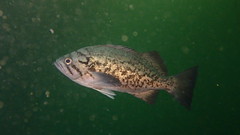
|
Blue Rockfish (BLU) Sebastes mystinus DISTINGUISHING FEATURES: Blue rockfish are blue or bluish-black with blackish fins and heavy dark gray or black mottling. Distinguished from black rockfish by mottling and length of jaw. Note the square anal fin. RCCA Notes: Look for the dark bars extending from the eye, which resemble tear streaks. “Blue rockfish have the blues, so they are crying.” SIZE: Blue rockfish reach a maximum length of 21 in (53 cm). DISTRIBUTION: Alaska to northern Baja CA (12). Range from tide pools to as deep as 1,800 ft (549 m), but most common in 15-200 ft (5-61 m). INTERESTING FACTS: Blue rockfish occur at specific locations for most of their lives and adults aggregate by size and sex; mixing occurs during mating. FISHERY: Important recreational, commercial and live-fish fishery in CA. STATUS: There is evidence that the recreational fishery at specific locations has overfished blue rockfish and catches from recreational vessels off southern CA dropped by 95% between 1980 and 1996. Additional pressure from the live-fish commercial fishery has severely depleted many concentrations of blue rockfish in recent years. |
Look for the dark bars extending from the eye, which resemble tear streaks. “Blue rockfish have the blues, so they are crying.” |
|

|
Blue Rockfish (BLU) Sebastes mystinus DISTINGUISHING FEATURES: Blue rockfish are blue or bluish-black with blackish fins and heavy dark gray or black mottling. Distinguished from black rockfish by mottling and length of jaw. Note the square anal fin. RCCA Notes: Look for the dark bars extending from the eye, which resemble tear streaks. “Blue rockfish have the blues, so they are crying.” SIZE: Blue rockfish reach a maximum length of 21 in (53 cm). DISTRIBUTION: Alaska to northern Baja CA (12). Range from tide pools to as deep as 1,800 ft (549 m), but most common in 15-200 ft (5-61 m). INTERESTING FACTS: Blue rockfish occur at specific locations for most of their lives and adults aggregate by size and sex; mixing occurs during mating. FISHERY: Important recreational, commercial and live-fish fishery in CA. STATUS: There is evidence that the recreational fishery at specific locations has overfished blue rockfish and catches from recreational vessels off southern CA dropped by 95% between 1980 and 1996. Additional pressure from the live-fish commercial fishery has severely depleted many concentrations of blue rockfish in recent years. |
Look for the dark bars extending from the eye, which resemble tear streaks. “Blue rockfish have the blues, so they are crying.” |
|

|
Black Rockfish (BLK) Sebastes melanops DISTINGUISHING FEATURES: They are black or blue-black, mottled with gray or blue-gray with black spots on their backs and dorsal fins. The upper jaw in black rockfish extends to the rear of the eye (blue rockfish jaw extends to the middle of the eye). RCCA Notes: Mottling is not uniform over entire body; below the lateral line molting is lessened. It's like someone has swiped their thumb across the fish's body SIZE: Maximum size of 25 in (63 cm) and 11 lbs.(11). DISTRIBUTION: Aleutian Islands to Huntington Beach, rare in southern CA. Adults are most abundant in waters between 40-300 ft (12–91 m). INTERESTING FACTS: Relatively mobile species; some individuals may move hundreds of miles. As with all members of this genus (Sebastes), fertilization and development takes place within the female’s body (live-bearers). FISHERY: This species is an important recreational and commercial fishery (particularly in northern California). STATUS: Most of the black rockfish taken by recreational anglers off CA are immature. Stock assessments in the mid 1990s indicate that black rockfish populations are in a general state of decline. |
Mottling is not uniform over entire body; below the lateral line molting is lessened. It's like someone has swiped their thumb across the fish's body |
|
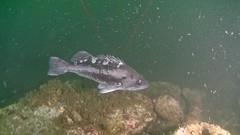
|
Black Rockfish (BLK) Sebastes melanops DISTINGUISHING FEATURES: They are black or blue-black, mottled with gray or blue-gray with black spots on their backs and dorsal fins. The upper jaw in black rockfish extends to the rear of the eye (blue rockfish jaw extends to the middle of the eye). RCCA Notes: Mottling is not uniform over entire body; below the lateral line molting is lessened. It's like someone has swiped their thumb across the fish's body SIZE: Maximum size of 25 in (63 cm) and 11 lbs.(11). DISTRIBUTION: Aleutian Islands to Huntington Beach, rare in southern CA. Adults are most abundant in waters between 40-300 ft (12–91 m). INTERESTING FACTS: Relatively mobile species; some individuals may move hundreds of miles. As with all members of this genus (Sebastes), fertilization and development takes place within the female’s body (live-bearers). FISHERY: This species is an important recreational and commercial fishery (particularly in northern California). STATUS: Most of the black rockfish taken by recreational anglers off CA are immature. Stock assessments in the mid 1990s indicate that black rockfish populations are in a general state of decline. |
Mottling is not uniform over entire body; below the lateral line molting is lessened. It's like someone has swiped their thumb across the fish's body |
|
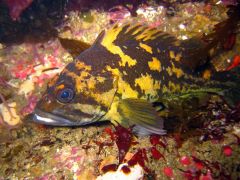
|
Black-and-Yellow Rockfish (BYR) Sebastes chrysomelas DISTINGUISHING FEATURES: Black-and-yellow rockfish are black or dark brown, with yellow areas on back. They closely resemble gopher, copper and China rockfish. RCCA Notes: These fish tend to hang out in cracks and caves. Only the head or tail may be visible. SIZE: Maximum length is 15.3 in (39 cm). DISTRIBUTION: Eureka northern CA to central Baja CA (10). Most common in waters less than 60 ft (18 m) deep but can be found to 120 ft (37 m). INTERESTING FACTS: When found with gopher rockfish, black-and-yellow rockfish segregate by depth, with the more aggressive individuals occupying shallower water. FISHERY: Black-and-yellow rockfish are a minor part of the recreational rockfish catch in California and Baja. However, they are targeted by commercial fisherman for the live fish trade. STATUS: Abundance has declined since the early 70’s but no formal stock assessments have been made. |
These fish tend to hang out in cracks and caves. Only the head or tail may be visible. |
|
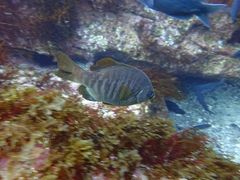
|
Black Perch (BLP) Embiotoca jacksoni DISTINGUISHING FEATURES: Body laterally compressed with forked tail and a shade of blue at the base of the anal fin. Patch of enlarged scales between the pectoral and pelvic fins and continuous dark bars on the side. Black perches look similar to redtail, rainbow and barred surfperches. RCCA Notes: Look for the dark upper lip (mustache) on these fish and the blue line at the base of the anal fin. SIZE: Black perches may live for 9 years or more and reach a length of up to 16 in (41 cm). Mature fish are 1-2 years old and up to 6 in (15 cm) long. DISTRIBUTION: Northern CA to Baja CA, most common in southern CA. Found from the intertidal-subtidal interface to depths of 165 ft (50m). INTERESTING FACTS: Also known as black surfperch or butterlips. Individuals swim alone or in small groups. This is a live-bearing fish. FISHERY: A very important sport fish in central and southern CA, targeted by divers and fisherman. A very small commercial fishery exists averaging ~400 lbs per year. STATUS: Thought to be stable, but official data are not available. |
Look for the dark upper lip (mustache) on these fish and the blue line at the base of the anal fin. |
|
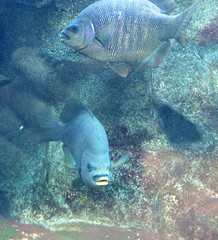
|
Black Perch (BLP) Embiotoca jacksoni DISTINGUISHING FEATURES: Body laterally compressed with forked tail and a shade of blue at the base of the anal fin. Patch of enlarged scales between the pectoral and pelvic fins and continuous dark bars on the side. Black perches look similar to redtail, rainbow and barred surfperches. RCCA Notes: Look for the dark upper lip (mustache) on these fish and the blue line at the base of the anal fin. SIZE: Black perches may live for 9 years or more and reach a length of up to 16 in (41 cm). Mature fish are 1-2 years old and up to 6 in (15 cm) long. DISTRIBUTION: Northern CA to Baja CA, most common in southern CA. Found from the intertidal-subtidal interface to depths of 165 ft (50m). INTERESTING FACTS: Also known as black surfperch or butterlips. Individuals swim alone or in small groups. This is a live-bearing fish. FISHERY: A very important sport fish in central and southern CA, targeted by divers and fisherman. A very small commercial fishery exists averaging ~400 lbs per year. STATUS: Thought to be stable, but official data are not available. |
Look for the dark upper lip (mustache) on these fish and the blue line at the base of the anal fin. |
|
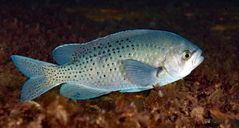
|
Blacksmith (BS) Chromis punctipinnis DISTINGUISHING FEATURES: Gray-blue with black spots on rear half of body and on soft dorsal fin and tail. During breeding season males may have a dark bar through the eye. This bar remains, but the coloration turns almost white in males guarding eggs. RCCA Notes: Blacksmith can be seen schooling and swimming through the water column. Juveniles have a yellow-orange tail and a blue-purple head. SIZE: Maximum length of 1 foot (30 cm). DISTRIBUTION: Monterey Bay to central Baja CA, rare north of Point Conception. Found around structures in shallow water to 150 ft (46 m). INTERESTING FACTS: The blacksmith is found in the same family as the garibaldi, our state marine fish. The males guard the nest until the eggs hatch. A schooling and diurnal species, at night these fish are found in groups in crevices. FISHERY: Of small sport fishery, particularly by divers (the small mouth prevents many hookups). A minor commercial value, species sometimes caught in perch catches. STATUS: Stable in the Channel Islands Sanctuary. |
Blacksmith can be seen schooling and swimming through the water column. Juveniles have a yellow-orange tail and a blue-purple head. |
|

|
Blacksmith (BS) Chromis punctipinnis DISTINGUISHING FEATURES: Gray-blue with black spots on rear half of body and on soft dorsal fin and tail. During breeding season males may have a dark bar through the eye. This bar remains, but the coloration turns almost white in males guarding eggs. RCCA Notes: Blacksmith can be seen schooling and swimming through the water column. Juveniles have a yellow-orange tail and a blue-purple head. SIZE: Maximum length of 1 foot (30 cm). DISTRIBUTION: Monterey Bay to central Baja CA, rare north of Point Conception. Found around structures in shallow water to 150 ft (46 m). INTERESTING FACTS: The blacksmith is found in the same family as the garibaldi, our state marine fish. The males guard the nest until the eggs hatch. A schooling and diurnal species, at night these fish are found in groups in crevices. FISHERY: Of small sport fishery, particularly by divers (the small mouth prevents many hookups). A minor commercial value, species sometimes caught in perch catches. STATUS: Stable in the Channel Islands Sanctuary. |
Blacksmith can be seen schooling and swimming through the water column. Juveniles have a yellow-orange tail and a blue-purple head. |
|
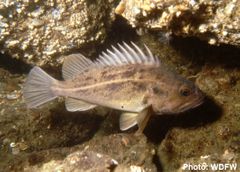
|
Brown Rockfish (BRR) Sebastes auriculatus DISTINGUISHING FEATURES: Mottled and blotched shades of tan to coral to brown; fins usually a pale color. Vague dark blotch on gill cover; sometimes very pronounced, other times can be hard to see. Can be confused with grass rockfish which is distinguished by dark greenish gray to black coloration with all fins being dark. RCCA Notes: Brown spot on gill cover can fade with age but is apparent if you look for it. These fish are uniformly brown with lighter fins. SIZE: Length to 21.5 inches (55 cm). DISTRIBUTION: From Prince William Sound, AK to Hipolito Bay, Baja California Sur. Around low profile reefs often in sandy or silty areas; in depths to 420 ft. (128 m). INTERESTING FACTS: Commonly referred to as bolina by fisherman. Brown rockfish may hybridize with copper rockfish in the Puget Sound.FISHERY: Low importance in recreational fishery but sold at high prices in the live-fish market. STATUS: Evidence that California brown rockfish stocks are stressed. No comprehensive assessment available. |
Brown spot on gill cover can fade with age but is apparent if you look for it. These fish are uniformly brown with lighter fins. |
|
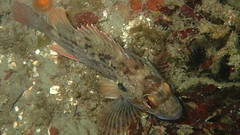
|
Brown Rockfish (BRR) Sebastes auriculatus DISTINGUISHING FEATURES: Mottled and blotched shades of tan to coral to brown; fins usually a pale color. Vague dark blotch on gill cover; sometimes very pronounced, other times can be hard to see. Can be confused with grass rockfish which is distinguished by dark greenish gray to black coloration with all fins being dark. RCCA Notes: Brown spot on gill cover can fade with age but is apparent if you look for it. These fish are uniformly brown with lighter fins. SIZE: Length to 21.5 inches (55 cm). DISTRIBUTION: From Prince William Sound, AK to Hipolito Bay, Baja California Sur. Around low profile reefs often in sandy or silty areas; in depths to 420 ft. (128 m). INTERESTING FACTS: Commonly referred to as bolina by fisherman. Brown rockfish may hybridize with copper rockfish in the Puget Sound. FISHERY: Low importance in recreational fishery but sold at high prices in the live-fish market. STATUS: Evidence that California brown rockfish stocks are stressed. No comprehensive assessment available. |
Brown spot on gill cover can fade with age but is apparent if you look for it. These fish are uniformly brown with lighter fins. |
|
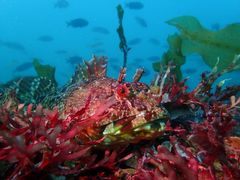
|
Cabezón (CAB) Scorpaenichthys marmoratus DISTINGUISHING FEATURES: Scaleless body with intense dark and light mottling; red coloration in 92% of males and green in 97% of females. Skin flap on snout; one branched cirrus above each eye. RCCA Notes: These fish have a very large head and tapered body. They are very good at blending in with the rock and will hold their ground, especially if they are guarding eggs. SIZE: Up to 30 in (76 cm), and lives about 13 years. DISTRIBUTION: Sitka, Alaska to Punta Abreojos, Baja CA. Found from the intertidal to 362 ft (110 m); most common at depths of 90 ft (27 m) (11). INTERESTING FACTS: They have blue flesh and poisonous eggs. Males guard the nest until the eggs hatch. NOTE: Egg masses under in picture. FISHERY: An important sport fish commonly taken by fishermen and divers. The historically small commercial market has recently increased to fuel the expansion of the live-fish trade in Asian markets and restaurants. STATUS: 2005 stock assessment indicates a portion of the stock in California is at 35% of unfished levels. |
These fish have a very large head and tapered body. They are very good at blending in with the rock and will hold their ground, especially if they are guarding eggs. |
|
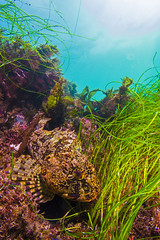
|
Cabezón (CAB) Scorpaenichthys marmoratus DISTINGUISHING FEATURES: Scaleless body with intense dark and light mottling; red coloration in 92% of males and green in 97% of females. Skin flap on snout; one branched cirrus above each eye. RCCA Notes: These fish have a very large head and tapered body. They are very good at blending in with the rock and will hold their ground, especially if they are guarding eggs. SIZE: Up to 30 in (76 cm), and lives about 13 years. DISTRIBUTION: Sitka, Alaska to Punta Abreojos, Baja CA. Found from the intertidal to 362 ft (110 m); most common at depths of 90 ft (27 m) (11). INTERESTING FACTS: They have blue flesh and poisonous eggs. Males guard the nest until the eggs hatch. NOTE: Egg masses under in picture. FISHERY: An important sport fish commonly taken by fishermen and divers. The historically small commercial market has recently increased to fuel the expansion of the live-fish trade in Asian markets and restaurants. STATUS: 2005 stock assessment indicates a portion of the stock in California is at 35% of unfished levels. |
These fish have a very large head and tapered body. They are very good at blending in with the rock and will hold their ground, especially if they are guarding eggs. |
|
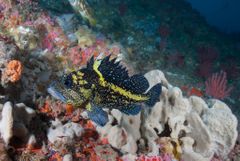
|
China Rockfish (CHR) Sebastes nebulosus DISTINGUISHING FEATURES: Bluish-black to black body with yellowish to white speckles over entire body. Yellow stripe (Nike© swoosh) starting on the front of the dorsal fin running the entire length of the lateral line to tail. RCCA Notes: These fish tend to hide in cracks and caves, only portions of their “starry night” body may be seen. “Check for China” - they have a checkmark on their side. SIZE: Length to 17.8 inches (45.3cm). DISTRIBUTION: From Prince William Sound, AK to Redondo Beach CA. In and around offshore reefs; in depths 10- 420 ft. (3–128 m). INTERESTING FACTS: Sedentary and likely territorial. They may remain in very small home range areas on a single reef for many years. FISHERY: Moderately important sportfish occasionally speared by divers and taken by rocky shore anglers. Valuable in live-fish fishery commanding high prices. STATUS: Recreational catch off California declining since late 1980’s. No comprehensive population assessment available. |
These fish tend to hide in cracks and caves, only portions of their “starry night” body may be seen. “Check for China” - they have a checkmark on their side. |
|
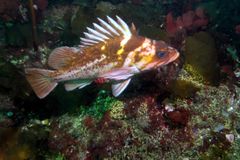
|
Copper Rockfish (COR) Sebastes caurinus DISTINGUISHING FEATURES: Adult coloration varies from white, pink, orange-red and brownish to almost black. All have patches of other colors, often copper or yellow. Usually two yellow, copper or orange stripes run backward from the eyes. The lateral line sits within a white line. RCCA Notes: Can easily be confused for gopher rockfish expect coppers have white unmarked fins (except for the dorsal fin). Gopher rockfish have darker fins. SIZE: Up to 22.5 in (57 cm). DISTRIBUTION: Gulf of Alaska southward to Baja CA; most abundant from British Columbia to southern CA. Range from 20-600 ft (6-193 m). INTERESTING FACTS: Because copper rockfish avoid warm water, adults live in deeper depths off southern CA than farther north. In British Columbia they are found in shallow water. FISHERY: Copper rockfish are a moderately important recreational species and an important commercial catch off British Columbia and CA. They are sold at high prices to Asian live-fish markets. STATUS: Undetermined, but there is evidence that populations have declined severely in most areas and large individuals are noticeably less common than in past decades. |
Can easily be confused for gopher rockfish expect coppers have white unmarked fins (except for the dorsal fin). Gopher rockfish have darker fins. Has strong white lateral line. |
|
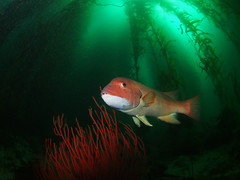
|
California Sheephead (Female) (SH-F) Semicossyphus pulcher DISTINGUISHING FEATURES: The adult female has pink to reddish body coloration. The chin is white, the body is deep and the teeth are dog-like. RCCA Notes: When surveying, categorize a sheephead as female if NO color blocking is present. SIZE: Up to 3 ft (91 cm) and slow growing. The females that become males do so in their eighth year at 12-14 in (30-36 cm). DISTRIBUTION: Central CA to Baja CA. Common south of Point Conception. Adults found deeper than 281 ft (86 m) but most common from 10-200 ft (3-61 m ). INTERESTING FACTS: CA Sheephead begin life as females and some later transition to males. Populations appear to increase with El Nino events. FISHERY: Chinese fishermen in the 1800s were responsible for most of the historical landings. Landings and price of sheephead increased with the beginning of the live-fish trade in the 1980s. Recently, the sport fishing catch often exceeds the commercial catch. STATUS: California population has likely been reduced to 20% of unfished level. |
When surveying, categorize a sheephead as female if NO color blocking is present. |
|

|
Garibaldi (Adult) (GAR-A) Hypsypops rubicundus DISTINGUISHING FEATURES: Bright reddish-orange body coloration. RCCA Notes: California marine state fish! Very curious and easily identifiable. Can also be territorial during breeding season. SIZE: Garibaldis may live up to 17 years and reach up to 14 in (36 cm) in length. Juveniles to 6 in (15 cm); breeding age and size are 6 years and 8-9 in (20-23 cm) respectively. Specimens measuring over 12 in (30 cm) are at least 10 years old. DISTRIBUTION: Monterey Bay to Magdalena Bay, Baja CA; including Guadalupe Island. Rare north of Point Conception. Found only in rocky reefs from the intertidal to approximately 95 ft (29 m). INTERESTING FACTS: The California state marine fish. An extremely territorial species that uses sound produced with its throat teeth to chase away intruders. FISHERY: Once targeted for the marine aquarium trade. It is now illegal to spear, capture or possess garibaldi. STATUS: Stable. |
California marine state fish! Very curious and easily identifiable. Can also be territorial during breeding season. |
|
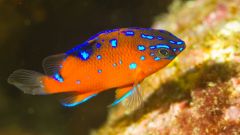
|
Garibaldi (Juvenile) (GAR-J) Hypsypops rubicundus DISTINGUISHING FEATURES: Rounded body with bright red-orange coloration and brilliant blue blotches. The tail is notched with lobes. RCCA Notes: A garibaldi with any blue markings is considered to be juvenile. SIZE: Garibaldis may live up to 17 years, and reach up to 14 in (36 cm) in length. Juveniles to 6 in (15 cm); breeding age and size are 6 years and 8-9 in (20-23 cm), respectively. Specimens measuring over 12 in (30 cm) are at least 10 years old. DISTRIBUTION: Monterey Bay to Magdalena Bay, Baja CA; including Guadalupe Island. Rare north of Point Conception. Found only in rocky reefs from the intertidal to approximately 95 ft (29 m). INTERESTING FACTS: The California state marine fish. An extremely territorial species that uses sound produced with its throat teeth to chase away intruders. FISHERY: Once targeted for the marine aquarium trade. It is now illegal to spear, capture or possess garibaldi. STATUS: Stable. |
A garibaldi with any blue markings is considered to be juvenile. |
|
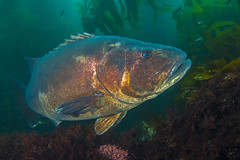
|
Giant Sea Bass (GSB) Stereolepis gigas DISTINGUISHING FEATURES: Dark gray body with black spots on sides, pale ventrally. Juveniles are bright red with black spots and large pectoral fins. RCCA Notes: While surveying, record this species if seen on or off transect. SIZE: Maximum length reported 7.4 ft (2.3 m). Can live up to 70-75 years. DISTRIBUTION: Humboldt Bay, including Guadalupe Island, to the Gulf of CA. Range extends from 18 to more than 150 ft (6-46 m). INTERESTING FACTS: The giant sea bass is also known as Jewfish and black sea bass. This slow growing species is the largest bony fish off the CA coast. FISHERY: The take of this previously popular sport fish has been made illegal since 1982. However, incidental commercial catch of this species does occur in gillnets. STATUS: Populations along the coast were severely depleted due to overfishing, but they appear to be recovering thanks to stricter laws and high survival rate of young. |
While surveying, record this species if seen on or off transect. |
|
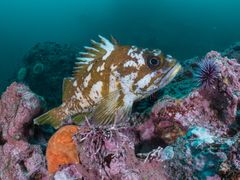
|
Gopher Rockfish (GOR) Sebastes carnatus DISTINGUISHING FEATURES: Similar pattern to S. chrysomelas (black and yellow rockfish), but coloration is brown with white-pink spots, while black and yellow rockfish are black or dark brown with yellow areas on back. Also looks similar to the copper rockfish; however gophers have dark pectoral fins. RCCA Notes: Three white lines (“1, 2, 3, Go-fer victory!”) extend down from spots on the dorsal fin onto upper body. SIZE: Maximum length is 17 in (42.5 cm). DISTRIBUTION: Cape Blanco, Oregon to southern Baja CA. Found from intertidal to 264 ft (80m). Most common at depths less than 60 ft (18 m) but can be found to 120 ft (37 m). INTERESTING FACTS: Largely territorial with home ranges up to 10–12 m^2. FISHERY: Gopher rockfish are a minor part of the recreational rockfish catch in CA and Baja. They are increasingly being targeted by commercial fisherman for the live-fish trade. STATUS: undetermined; no comprehensive assessments exist for CA stock, but their low fecundity, restricted habitats and limited mobility make them more susceptible to local fishing pressures. |
Three white lines (“1, 2, 3, Go-fer victory!”) extend down from spots on the dorsal fin onto upper body. |
|
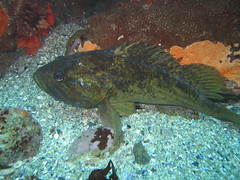
|
Grass Rockfish (GRR) Sebastes rastrelliger DISTINGUISHING FEATURES: Thick, very stout bodies, dark green to almost black dorsally, lighter ventrally, with black spotting. A black blotch may be observed on the upper edge of the gill cover. Fins are dark and pectoral fins may have a pink tinge in adults. Orange-yellow grass rockfish are rare. RCCA Notes: Unlike the brown rockfish, grass rockfish do not have the brown spot on the operculum and have smaller eyes than a kelp rockfish. Grass rockfish are often found sitting on the ocean floor. SIZE: Up to 22 in (56 cm). DISTRIBUTION: Central Oregon to central Baja CA. These are shallow water fish that are rarely found deeper than 150 ft (46 m). INTERESTING FACTS: One of the few rockfish species that inhabit shallower waters. The grass rockfish reproduces slowly and tends to be sedentary. FISHERY: The live grass rockfish market is growing in CA and southern Oregon. Recreational anglers and divers account for a considerable portion of the landings. Restrictions since 1998 have set a size limit of 12 in (31 cm). STATUS: Undetermined, no comprehensive assessments exist. |
Unlike the brown rockfish, grass rockfish do not have the brown spot on the operculum and have smaller eyes than a kelp rockfish. These rockfish are often found sitting on the ocean floor. |
|
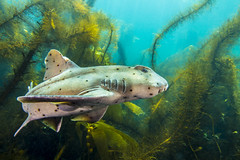
|
Horn Shark (HS) Heterodontus francisci DISTINGUISHING FEATURES: Gray to brown body with dark spots and wide ridges above eyes. Its two dorsal fins are widely separated and each has a spine at its base. RCCA Notes: Horn sharks can have blotches or be spot-free and generally hide in the rocks. SIZE: Up to 38 in (97 cm). Freshly hatched juveniles are about 6 in (15 cm) long while sexually mature specimens are about 2 ft (61 cm). DISTRIBUTION: Monterey Bay to the Gulf of CA; common in southern CA. Adults are found from the intertidal to 492 ft (150 m) (11). INTERESTING FACTS: Nocturnal; often spends its days among rocks, crevices or algae. Adults tend to return to the same resting place every day. FISHERY: Occasionally taken as incidental catch by anglers and more often by commercial vessels fishing for lobsters or crabs in traps. STATUS: Unknown. |
These sharks can have blotches or be spot-free and generally hide in the rocks. |
|
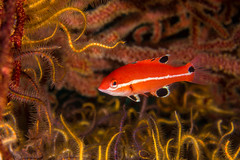
|
California Sheephead (Juvenile) (SH-J) Semicossyphus pulcher DISTINGUISHING FEATURES: Red-orange with at least one white stripe running from the eye to the base of the tail. Large black spots on the fins and base of tail. RCCA Notes: Juveniles have black spots and a white stripe. SIZE: Up to 3 ft (91 cm). Females in their fourth year are sexually mature and sex change takes place in the eighth year at 12-14 in (30-36 cm) (10). DISTRIBUTION: Central CA to Baja CA; common south of Point Conception. Depth range from 10-100 ft (3-30 m). INTERESTING FACTS: All CA Sheephead begin life as females and some transition to males. Populations appear to increase with El Nino events. FISHERY: Chinese fishermen in the 1800s were responsible for most of the catch. Landings and price increased with the beginning of the live-fish trade in the 1980s, but the sport fishing catch often exceeds the commercial catch. STATUS: California population has likely been reduced to 20% of unfished level. |
Juveniles have black spots and a white stripe. |
|
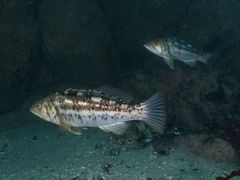
|
Kelp Bass (KB) Paralabrax clathratus DISTINGUISHING FEATURES: Olive-brown with white blotches on back and sides; pale ventrally. The first two dorsal spines are smaller than the rest. Breeding and older males may have orange chins. RCCA Notes: Upper 1/2 is molted and lower 1/2 is silver yellow (checkerboard markings). Similar looking fish such as olive rockfish have white spots throughout rather then the dark molting. SIZE: Up to 28.5 in (72 cm) and survive for at least 33 years. Sexually mature individuals measure at least 10.5 in (27 cm). DISTRIBUTION: Columbia River to Baja CA, rare north of Pt. Conception. Found from the shallow subtidal to at least 200 ft (61 m) depths. INTERESTING FACTS: Also known as calico bass, this species likes to live in kelp beds, oil platforms and sewer pipes. A solitary species that assembles in groups to prey on other fishes and can leap out of the water in pursuit of prey. FISHERY: One of the most important nearshore recreational species in the southern CA waters. STATUS: The decline in abundance and size of catch since the 1990s is a major cause for concern. |
Upper 1/2 is molted and lower 1/2 is silver yellow (checkerboard markings). Similar looking fish such as olive rockfish have white spots throughout rather then the dark molting. |
|
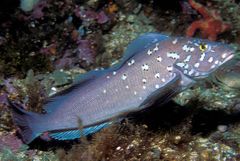
|
Kelp Greenling (Male) (KG-M) Hexagrammos decagrammus DISTINGUISHING FEATURES: Males are dark gray with bright blue spots on head region. Spiny and soft-rayed dorsal fins of about equal length and divided by a notch; one small cirrus per eye. This species can be mistaken for lingcod and other greenlings. RCCA Notes: Males can be deep red in body color and always have blue spots on the head region. Males have “Braveheart” war paint on their faces. May follow diver along transect—be careful not to count twice. SIZE: Up to 21 in (53 cm) in length. DISTRIBUTION: Aleutian Islands, Alaska to San Diego, CA. Unusual south of Morro Bay, CA. Found from tide pools to 150 ft (46 m) deep. INTERESTING FACTS: This species has five lateral lines. Its texture and taste are comparable to those of lingcod.
FISHERY: Primarily of sport fishing importance. Commercial catch was largely incidental to lingcod or rockfish landings, but since 1997 it has grown due to the live-fish market. STATUS: Although no formal assessments exist, a continuous decline in sport landings has occurred since 1993. Such decline is thought to indicate depleted stocks due to affected recruitment by overfishing. |
Males can be deep red in body color and always have blue spots on the head region. Males have “Braveheart” war paint on their faces. May follow diver along transect—be careful not to count twice. |
|
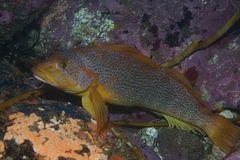
|
Kelp Greenling (Female) (KG-F) Hexagrammos decagrammus DISTINGUISHING FEATURES: Elongated body with spiny and soft-rayed dorsal fins of about equal length and divided by a notch; one small cirrus above each eye. Females are gray-brown with bright golden to brown spots on body and head. This species may be confused with the lingcod and other greenlings. RCCA Notes: Females have uniform speckling over their entire body (wearing a shiny, blue sequined dress). They may follow divers along transect - be careful not to count twice. SIZE: Up to 21 in (53 cm). DISTRIBUTION: Alaska to San Diego, CA; unusual south of Morro Bay, CA. Found from tide pools to 150 ft (46 m) deep. INTERESTING FACTS: This species has five lateral lines. Its texture and taste are comparable to those of lingcod.
FISHERY: Primarily of sport fishing importance. Commercial catch was largely incidental to lingcod or rockfish landings, but since 1997 it has grown due to the live-fish market. STATUS: Although no formal assessments exist, a continuous decline in sport landings has occurred since 1993. Such decline is thought to indicate depleted stocks due to affected recruitment by overfishing. |
Females have uniform speckling over their entire body (wearing a shiny, blue sequined dress). They may follow divers along transect - be careful not to count twice. |
|

|
Kelp Greenling (Female) (KG-F) Hexagrammos decagrammus DISTINGUISHING FEATURES: Elongated body with spiny and soft-rayed dorsal fins of about equal length and divided by a notch; one small cirrus above each eye. Females are gray-brown with bright golden to brown spots on body and head. This species may be confused with the lingcod and other greenlings. RCCA Notes: Females have uniform speckling over their entire body (wearing a shiny, blue sequined dress). They may follow divers along transect - be careful not to count twice. SIZE: Up to 21 in (53 cm). DISTRIBUTION: Alaska to San Diego, CA; unusual south of Morro Bay, CA. Found from tide pools to 150 ft (46 m) deep. INTERESTING FACTS: This species has five lateral lines. Its texture and taste are comparable to those of lingcod. FISHERY: Primarily of sport fishing importance. Commercial catch was largely incidental to lingcod or rockfish landings, but since 1997 it has grown due to the live-fish market. STATUS: Although no formal assessments exist, a continuous decline in sport landings has occurred since 1993. Such decline is thought to indicate depleted stocks due to affected recruitment by overfishing. |
Females have uniform speckling over their entire body (wearing a shiny, blue sequined dress). They may follow divers along transect - be careful not to count twice. |
|

|
Kelp Greenling (Male) (KG-M) Hexagrammos decagrammus DISTINGUISHING FEATURES: Males are dark gray with bright blue spots on head region. Spiny and soft-rayed dorsal fins of about equal length and divided by a notch; one small cirrus per eye. This species can be mistaken for lingcod and other greenlings. RCCA Notes: Males can be deep red in body color and always have blue spots on the head region. Males have “Braveheart” war paint on their faces. May follow diver along transect—be careful not to count twice. SIZE: Up to 21 in (53 cm) in length. DISTRIBUTION: Aleutian Islands, Alaska to San Diego, CA. Unusual south of Morro Bay, CA. Found from tide pools to 150 ft (46 m) deep. INTERESTING FACTS: This species has five lateral lines. Its texture and taste are comparable to those of lingcod. FISHERY: Primarily of sport fishing importance. Commercial catch was largely incidental to lingcod or rockfish landings, but since 1997 it has grown due to the live-fish market. STATUS: Although no formal assessments exist, a continuous decline in sport landings has occurred since 1993. Such decline is thought to indicate depleted stocks due to affected recruitment by overfishing. |
Males can be deep red in body color and always have blue spots on the head region. Males have “Braveheart” war paint on their faces. May follow diver along transect—be careful not to count twice. |
|
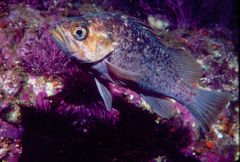
|
Kelp Rockfish (KR) Sebastes atrovirens DISTINGUISHING FEATURES: Deep body with round tail; the pectoral fins are relatively longer, thinner and more transparent than on other rockfishes. Coloration olive tan to pink-brown with dark spotting concentrated on the head and back. RCCA Notes: Coloration can differ but the large eye of the kelp rock is a dead give away. Nicknamed “dumb bass”. SIZE: Up to 17 in. (43 cm) and live for at least 25 years. DISTRIBUTION: Sonoma county, Northern CA to Central Baja CA. Found from the shallow subtidal to 150 ft. INTERESTING FACTS: Kelp rockfishes are also called dumb basses and Rocots. They like to hang out around kelp either alone or in groups. These fish are sedentary, but changes in kelp density may trigger migration. FISHERY: This species became commercially important in the 1990s. A high percentage of the landings is by recreational anglers and divers. Kelp rockfish may also be caught for aquarium display. STATUS: Undetermined, no comprehensive population assessments exist. |
Coloration can differ but the large eye of the kelp rock is a dead give away. Nicknamed “dumb bass”. |
|

|
Kelp Rockfish (KR) Sebastes atrovirens DISTINGUISHING FEATURES: Deep body with round tail; the pectoral fins are relatively longer, thinner and more transparent than on other rockfishes. Coloration olive tan to pink-brown with dark spotting concentrated on the head and back. RCCA Notes: Coloration can differ but the large eye of the kelp rock is a dead give away. Nicknamed “dumb bass”. SIZE: Up to 17 in. (43 cm) and live for at least 25 years. DISTRIBUTION: Sonoma county, Northern CA to Central Baja CA. Found from the shallow subtidal to 150 ft. INTERESTING FACTS: Kelp rockfishes are also called dumb basses and Rocots. They like to hang out around kelp either alone or in groups. These fish are sedentary, but changes in kelp density may trigger migration. FISHERY: This species became commercially important in the 1990s. A high percentage of the landings is by recreational anglers and divers. Kelp rockfish may also be caught for aquarium display. STATUS: Undetermined, no comprehensive population assessments exist. |
Coloration can differ but the large eye of the kelp rock is a dead give away. Nicknamed “dumb bass”. |
|
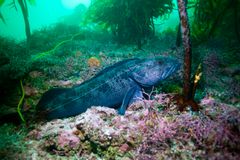
|
Lingcod (LIN) Ophiodon elongatus DISTINGUISHING FEATURES: Elongate body with spiny and soft-rayed dorsal fins separated by a notch. Color varies from gray to blue; heavily spotted. Lips are large and extend back to under the eye; the teeth are canine-like. RCCA Notes: Heads of larger lingcod will flatten out but body stays elongated and tapers to a skinny tail. SIZE: Up to 5 ft (1.5 m) and may live up to 20 years. Mature males measure 20 in. (51 cm) and females 24 in (61 cm). DISTRIBUTION: Alaska to Baja. Found in the intertidal to 1,620 ft (494 m). INTERESTING FACTS: Occasionally, lingcod with green flesh may be encountered, but this coloration disappears upon cooking. FISHERY: A valuable food source dating from 6200 BC to the present. Northern and central CA yield a large fraction of both commercial and recreational landings. STATUS: The population declined more than 75% since the 1970s and lingcod was declared overfished in 1999. A fast recruitment rate coupled with management strategies are likely to help rebuild the population above target levels. |
Heads of larger individuals will flatten out but body stays elongated and tapers to a skinny tail. Usually blueish in color. |
|

|
California Sheephead (Male) (SH-M) Semicossyphus pulcher DISTINGUISHING FEATURES: Black head and tail separated by a red band in the middle. The chin is white, the body is deep and the teeth are canine. RCCA Notes: While surveying, record as a make if coloring blocking is present. SIZE: Up to 3 ft (91 cm) and slow-growing. Males may live up to 53 years. DISTRIBUTION: Central CA to Baja CA. This species is common south of Point Conception. Adults found deeper than 281 ft (86 m), but most common between 10-200 ft (3-61 m). INTERESTING FACTS: CA Sheephead begin life as females and some later transition to males. Populations appear to increase with El Nino events. FISHERY: Chinese fishermen in the 1800s were responsible for most of the catch. Landings and price increased with the beginning of the live-fish trade in the 1980s, but the sport fishing catch often exceeds the commercial catch. STATUS: California population has likely been reduced to 20% of unfished level. |
While surveying, record as a make if coloring blocking is present. |
|
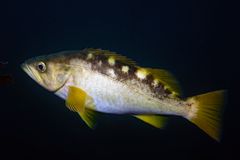
|
Olive Rockfish (OYR) Sebastes serranoides DISTINGUISHING FEATURES: The body is dark brown on the back and light brown on the sides. There are a series of light blotches on the back. Fins are olive to bright yellow in color. Olives can easily be mistaken for Yellowtail rockfish or Kelp bass. RCCA Notes: Olive rockfish have white spots on their backs, similar to kelp bass, however, on kelp bass the spots do not extend pass the lateral line. Olive and yellowtail are grouped to prevent misidentification. SIZE: Maximum length is 24 in (61 cm). DISTRIBUTION: Olive rockfish range from Northern CA (Redding Rock) to central Baja CA, and are abundant from southern CA to Mendocino County (northern CA). Most common from 15–180 ft (5-55 m) but have been found up to 570 ft (174 m). INTERESTING FACTS: Olive rockfish may form large aggregations, but are often found singly in blue rockfish schools. FISHERY: Important recreational fishery, but form a minor part of the commercial fishery. STATUS: There have been no stock assessments of this species, but there is evidence that olive rockfish have declined in abundance south of Pt. Conception. |
These fish have white spots on their backs, similar to kelp bass, however, on kelp bass the spots do not extend pass the lateral line. |
|
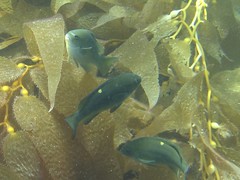
|
Opaleye (OPE) Girella nigricans DISTINGUISHING FEATURES: One to two light spots on each flank and opal blue eyes. The body is perch-like with an olive-green coloration and a white bar across the snout. Juveniles are dorsally blue and ventrally silver. RCCA Notes: Opaleye can be a nondescript gray fish but always have a light spot on each flank. SIZE: Average adult size of 1 ft (30cm). Maximum size up to 26 in (66cm). DISTRIBUTION: Otter Rock, Oregon to southern Baja, CA. Adults found deeper than 100 ft (30 m), but the average range is 5-65 ft (2-20 m). INTERESTING FACTS: Regulates kelp growth and can potentially overgraze causing damage to newly transplanted or isolated kelp plants or small kelp beds. Juveniles have been reported to act as cleaner fish. FISHERY: The commercial catch has been small. The highest recorded catch of opaleye was 23,688 pounds in 1973 and very small landings have been recorded after 1995. The live-fish market for opaleye has been increasing since 1999. STATUS: Stable with regular recruitment. |
Opaleye can be a nondescript gray fish but always have a light spot on each flank. |
|
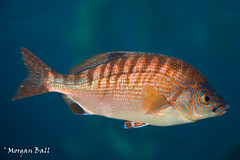
|
Rainbow Sea Perch (RAP) Hypsurus caryi DISTINGUISHING FEATURES: Silvery-blue undercolor with bronze to copper irregular bars extending down from dorsal area. Black spot at fin bases and at the corner of the mouth; flattened abdomen. RCCA Notes: Very “pretty” fish who has had a “tummy tuck” and has a black “beauty spot” on the side of the lip. SIZE: Up to 12 in (31 cm). DISTRIBUTION: Cape Mendocino to Baja California; rare south of Point Conception. Found from the inshore waters to 132 ft (40m). INTERESTING FACTS: Divers have seen rainbow surfperch cleaning ocean sunfish. FISHERY: Rarely. STATUS: Unknown. |
Very “pretty” fish who has had a “tummy tuck” and has a black “beauty spot” on the side of the lip. |
|

|
Pile perch (PIP) Rhacochilus vacca DISTINGUISHING FEATURES: A large perch species, dorsally dark and ventrally silver with a deeply forked tail. A dark bar originating at the base of the soft dorsal fin bisects the body. The dorsal soft rays are twice as long as the dorsal spines. RCCA Notes: Look for the light spot at the top of the black bar (like a bird pooped off a pier piling onto the fish). Bar is also located on the back portion of the body. SIZE: Up to 17.5 in (44 cm) and live at least 9 years. DISTRIBUTION: Port Wrangell, Alaska to Baja CA. Found as deep as 690 ft (210 m) but are more common from 10-60 ft (3-18 m). INTERESTING FACTS: This live-bearing species moves closer to shore during the colder months and returns to cooler waters during the warmer months. It is diurnal and may be found alone or in larger groups near the bottom. Its molar teeth are used to crash hard shell mollusks. FISHERY: Of sport fishing interest; caught year round by spear divers or from shore or skiffs. A small commercial fishery exists in Del Mar, CA and Papalote Bay, Baja CA, but the total state commercial landings are small. STATUS: Unknown. |
Look for the light spot at the top of the black bar (like a bird pooped off a pier piling onto the fish). |
|

|
Rock wrasse (Female) (RW-F) Halichoeres semicinctus DISTINGUISHING FEATURES: Cigar-shaped body and large forward-pointing teeth. Green to orange with dark blotches on the dorsal side. RCCA Notes: Females have black spots or “eggs” along their back and can be seen scurrying near the bottom or around rocks.SIZE: Up to 15 in (38 cm). Females mature in their second year at 5-6 in (13-15 cm) and turn into males in their fifth year. DISTRIBUTION: Central CA to the Gulf of CA, more common towards the south. Range from tide pools to 132 ft (40 m); more common in 10-50 ft (3-50 m). INTERESTING FACTS: Begin life as females and some transition to males at about 5 years of age. This is a diurnal species known to bury itself in kelp or sand at night. FISHERY: Divers often report wrasses to be very unapproachable and hard to spear. Rocky reef fishers catch a few, but sport fishers have trouble hooking them because of their small mouth. STATUS: Unknown. |
They are carrying their "eggs" on back |
|

|
Rock wrasse (Male) (RW-M) Halichoeres semicinctus
DISTINGUISHING FEATURES: Cigar-shaped body and large forward-pointing teeth. Green to orange with dusky vertical bars and a yellowish belly. Adult males have a blue to black bar behind the yellow-orange pectoral fins. RCCA Notes: Look for the “hairy armpits” under the pectoral fin on the males. SIZE: Up to 15 in (38 cm). Females mature in their second year at 5-6 in (13-15 cm) and change into males at about 5 years of age. DISTRIBUTION: Central CA to the Gulf of CA, more common towards the south. Range from tide pools to 132 ft (40 m); more common in 10-50 ft (3-50 m). INTERESTING FACTS: Begin life as females and some transition to males at about 5 years of age. This is a diurnal species known to bury itself in kelp or sand at night. FISHERY: Divers often report wrasses to be very elusive and hard to spear. Rocky reef fishermen catch a few, but sport fishermen have trouble hooking them because of their small mouth. STATUS: Unknown. |
Hairy Armpits |
|

|
Rubberlip Sea Perch (RUB) Rhacochilus toxotes DISTINGUISHING FEATURES: Adults are olive to brown with brassy overtones. The lips are very large and thick. The pectoral fins are yellow to orange and the pelvic fins are black. Adults display one to two dark lateral bars. RCCA Notes: Unlike the pile surfperch, the tail is not deeply forked but slightly indented. The large lips are a dead give away. SIZE: Up to 18.5 in (47 cm). DISTRIBUTION: From Mendocino County to central Baja CA. Found from shallow subtidal to 156 ft (48 m); more common in 10-100 ft (3-30 m). INTERESTING FACTS: The rubberlip is the largest representative of the family Embiotocidae. The mouth is used as a suction device to feed on attached invertebrates that are later efficiently separated from other inedible material without the help of a tongue. FISHERY: One of the many important surfperch sport fish in California. The average catch is 19,000 with a high in 1993 of 44,000 fish. Its commercial importance is small with less than 1,000 fish per year in southern California. STATUS: Unknown; no recent estimates exist. |
What big lips! |
|
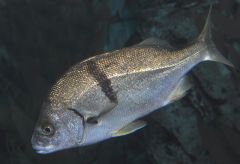
|
Sargo (SAR) Anisotremus davidsonii DISTINGUISHING FEATURES: Deep body, dorsally gray and ventrally silver; albino and golden sargo have been observed. A dark bar below the dorsal fin extends to area under the pectoral fin. Sargo may be confused with pile or rubberlip perches but are differentiated by body shape and location of bar. RCCA Notes: Sargo look very similar to pile perch; however sargo have a more prominent humpback and a mid-body bar. SIZE: Reported up to 23 in (58 cm), but the average length is 18 in (44 cm). DISTRIBUTION: Santa Cruz, CA to Magdalena Bay, Baja CA; rare north of Pt. Conception. Range form shallow subtidal waters to 198 ft (60 m). INTERESTING FACTS: Sargo tolerate higher than average salinity and have thus thrived as an introduced species in the Salton Sea. FISHERY: Shore and pier fishermen in southern California commonly catch Sargo and it has also become important in the Salton Sea since its introduction in 1951. Sargo is occasionally taken in gill and lampara nets and sold with perch. STATUS: Abundant in the Salton Sea, but their status in marine waters is unknown. |
Not a Pile Sea Perch but...... |
|

|
Señorita (SEN) Oxyjulis californica DISTINGUISHING FEATURES: Elongate body covered with large scales. Dark orange dorsally and paler ventrally with a black blotch at the base of the tail. RCCA Notes: Look for its black spot. Senorita might be seen cleaning blacksmith. Similar looking to female rock wrasses but senorita have no speckles and are found up in the water column versus rock wrasse, which are near the rocks. SIZE: Up to 11.7 in (30 cm), but the average length is 10 in (25 cm). DISTRIBUTION: Northern CA to Baja CA; more common south of Pt. Conception during the colder months. Common in 5-240 ft (2-73 m) depths. INTERESTING FACTS: The most common cleaner fish in the California area. FISHERY: Although they are sometimes caught on small baited hook, the general consensus is that señoritas are a bait-stealing nuisance. STATUS: The population seems to be stable within the waters of the Channel Islands Sanctuary, but wider range data is not available. |
Look for its black spot. Senorita might be seen cleaning blacksmith. Similar looking to female rock wrasses but senorita have no speckles and are found up in the water column versus rock wrasse, which are near the rocks. |
|
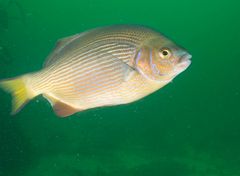
|
Striped Seaperch (STP) Embiotoca lateralis DISTINGUISHING FEATURES: The body displays red, blue and yellow stripes and dusky pelvic fins. RCCA Notes: An orange line can be seen above the lateral line. Shape is similar to black perch but it has horizontal stripes rather than vertical bars. SIZE: Up to 15 in (38 cm). Individuals generally attain sexual maturity in the third year at 9-10 in (23-25 cm). DISTRIBUTION: Port Wrangell, Alaska to Pt. Cabras, Baja CA. Range extends from the intertidal to 150 ft (46 m). INTERESTING FACTS: Also known as blue perch. A female can bear up to 92 live young. Their remains have been found in Native American middens. FISHERY: Of minor commercial importance but comprises a substantial portion of the state’s sport fishery. The colorful body of this species makes it a favorite of anglers. STATUS: Although accurate data are unavailable, recent fishery figures indicate that current levels of recruitment should be able to sustain a healthy sport catch. |
An orange line can be seen above the lateral line. Shape is similar to black perch but it has horizontal stripes rather than vertical bars. |
|
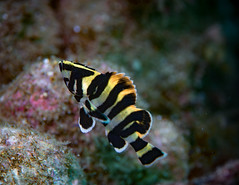
|
Treefish (Juvenile) (TREJ) Sebastes serriceps DISTINGUISHING FEATURES: Treefish have a series of 5-6 black or dark green bars alternating with yellow or olive bars. Two bars radiate from each eye and their lips are distinctively reddish-pink. RCCA Notes: Juvenile treefish are more brightly colored and can have white trim along their fins. DISTRIBUTION: San Francisco to central Baja CA; more numerous south of Santa Barbara. Found as deep as 150 ft (46 m) but more common between 20-140 ft (6-43 m). INTERESTING FACTS: Treefish occasionally fight over territories and temporarily have swallowed part of the head of their opponent. FISHERY: Not an important commercial fish in southern California, but are more increasingly taken in the live-fish fishery . Also taken by recreational anglers . STATUS: There is no comprehensive assessment of treefish populations. |
These juveniles are more brightly colored and can have white trim along their fins. |
|
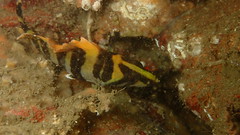
|
Treefish (TRE) Sebastes serriceps DISTINGUISHING FEATURES: Treefish have a series of 5-6 black or dark green bars alternating with yellow or olive bars. Two bars radiate from each eye and their lips are distinctively reddish-pink. SIZE: Maximum length is 16 in (41 cm). DISTRIBUTION: San Francisco to central Baja CA; more numerous south of Santa Barbara. Found as deep as 150 ft (46 m) but more common between 20-140 ft (6-43 m). INTERESTING FACTS: Treefish occasionally fight over territories and temporarily have swallowed part of the head of their opponent. FISHERY: Not an important commercial fish in southern California, but are more increasingly taken in the live-fish fishery . Also taken by recreational anglers . STATUS: There is no comprehensive assessment of treefish populations. |
These fish have a series of 5-6 black or dark green bars alternating with yellow or olive bars. Two bars radiate from each eye and their lips are distinctively reddish-pink |
|
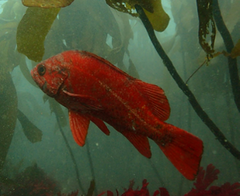
|
Vermillion Rockfish (VCR) Sebastes miniatus DISTINGUISHING FEATURES: Vermillion rockfish vary in color from bright red to orange-red, with light or dark mottling on backs and sides. This species resembles the Canary rockfish, but can be distinguished by its more intense red coloration and black band on edges of fins. RCCA Notes: Has a prominent white lateral line. Grouped with canary rockfish to prevent misidentification. SIZE: Maximum length is 30 in (76 cm). DISTRIBUTION: Alaska to central Baja CA. Range from the shallow subtidal to depths of 1,440 ft (439 m). INTERESTING FACTS: Vermillion rockfish were the most important of the rockfishes in the San Diego fish markets of the nineteenth century. FISHERY: An important recreational and commercial fish, however it is difficult to determine what percent of the commercial catch is comprised of Vermillion rockfish because individuals are often misidentified. STATUS: No recent data on stock assessment is available. However, in southern CA the recreational catch is composed almost entirely of juvenile fishes. |
Has a prominent white lateral line. Grouped with canary rockfish to prevent misidentification. |
|
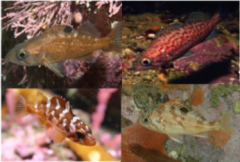
|
Young-of-the-year Rockfish (YOY) Sebastes spp. DISTINGUISHING FEATURES: Traditional rockfish shape but with colors and markings different from their adult counterparts RCCA Notes: YOYs don’t need to be measured to the nearest cm, just counted and they must be 10 cm or smaller. SIZE: 10 cm or less DISTRIBUTION: There are 65 species of rockfishes ranging from the Bering Sea to Baja. INTERESTING FACTS: Rockfishes have live-births of their larvae as opposed to laying eggs, which is relatively uncommon method of reproduction in marine fishes. STATUS: Due to several factors including oceanographic conditions the abundances of YOY, rockfishes seen in rocky reef ecosystems varies dramatically from year to year. |
Traditional rockfish shape but with colors and markings different from their adult counterparts |
|
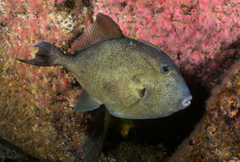
|
Finescale Triggerfish (TGF)Balistes polylepis DISTINGUISHING FEATURES: Robust, compressed, oblong body with a singular-looking dorsal fin. They are uniform brownish-tan in color with hints of blue throughout their body with blue spots on their head, blue rims on the median fins and blue lips. They are covered with thick, leathery skin composed of small and fine scales. Their dorsal fin has three spines and they have a small beak-like mouth. RCCA Notes: While surveying, record this species if seen on or off transect. SIZE: Maximum length of 32 in (80cm) and up to 16 lb (7.3kg) (45). DISTRIBUTION: Metalakatla in Southeastern Alaska to San Antonio in central Chile, including the Gulf of California and Hawai’i (45). INTERESTING FACTS: They are usually solitary, but it has been reported that they form aggregations on the bottom during their reproductive season. They rest at night, lying on their sides, both in the sand and inside reefs (45). FISHERY: Finescales are occasionally caught from shore, piers and boats in Southern California. They are an important fishery in the Gulf of California and along the Mexican coast and are common bycatch in the shrimp trawl fisheries in those regions (45). STATUS: There is no population information for this species, but it is common within its range and is of least concern (46). |
While surveying, record this species if seen on or off transect. |
|

|
Largemouth Blenny Labrisomus xanti DISTINGUISHING FEATURES: Greenish-brown in color with shortened, elongated robust bodies that taper at the rear into the tail. They are covered in small smooth scales and have eight dark bars along their sides and two thin dark stripes bordering their eyes. They have a black blotch at the front of their dorsal fin and many small white spots on the lower part of their body with branched cirrus over each of their large eyes. The breeding males are red in color. RCCA Notes: Mostly found in Southern California. Record if found anywhere on site. SIZE: Maximum length 7.1 in (18 cm) (48). DISTRIBUTION: Mexico’s central Pacific coast (south to Acapulco including the Revillagigedo Islands and Tres Marias Islands), the Gulf of California and Pacific coast of Baja California (north to central Baja). Largemouth blenny were first reported in California in 2015, near La Jolla, and are now their fairly common at Santa Catalina Island (48). INTERESTING FACTS: They are highly territorial diurnal predators that feed on benthic crustaceans, including small crabs. Their reproduction is oviparous and the females deposit the eggs in protected areas (49). FISHERY: Largemouth blennies are of limited interest to most due to their small size (49). STATUS: Unknown.
|
Greenish-brown in color with shortened, elongated robust bodies that taper at the rear into the tail. They have blue eyes and large lips. |
|

|
Halfmoon (HFM) Medialuna californiensis DISTINGUISHING FEATURES: The body is compressed and oval shaped with a blunt and rounded head and a small mouth. The tail is shaped like a halfmoon. The coloration can vary, but generally, they are grey-blue above the lateral line and silvery-white below the lateral line. RCCA Notes: They can be seen schooling and swimming through the water column. They have a distinct black thumbprint looking spot at the top of their gill cover or operculum. SIZE: Maximum length of 19 in (48.3 cm) with a maximum weight of 4.8 lb (2.2 kg) (45). DISTRIBUTION: Vancouver Island in British Columbia to the southwestern corner of the Gulf of California. They are found in shallow rocky areas and in kelp beds and have been observed as deep as 130 ft (45). INTERESTING FACTS: Mediauna is translated to mean “half moon” in Spanish, which refers to the shape of their tail. They are capable of changing color and pattern when frightened by predators and they are closely related to another RCCA species, the Opaleye (45). FISHERY: The Halfmoon was a very important commercial species in the 19th century and was taken in large numbers with gill nets off Santa Catalina Island and sold in Los Angeles. In the 20th century catches declined and today, they are rarely part of commercial take. Recreational anglers commonly take them from vessels, from rocky shores, and from a few piers (such as Avalon, Santa Catalina Island) (45). STATUS: Stable. It is considered common in California with no evidence of recent population change (47). |
The tail is shaped like a halfmoon. The coloration can vary, but generally, they are grey-blue above the lateral line and silvery-white below the lateral line. |
|
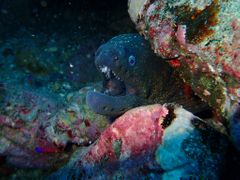
|
California Moray Eel (MRE)Gymnothorax mordax DISTINGUISHING FEATURES: Long slim, snakelike fish that is light to dark brown or green, often with dark mottling. Unlike most fish, they have no pectoral fins, pelvic fins, or scales. They have a fused dorsal fin that runs along their entire body, a large mouth with sharp, pointed teeth and small round gill openings on either side of their body. RCCA Notes: While surveying, record the number of morays you see on transect, but you don’t have to size them. They’re normally found in the cracks and crevices of rocky reefs. Record on Invert and Fish transects. SIZE: Maximum length of 5 ft (152 cm) (45). DISTRIBUTION: Point Conception (California) to Bahia Magdalena (southern Baja California). Occasionally found in tide pools and down to 131ft (40m). Usually found in subtidal waters to 65ft (20m) (45). INTERESTING FACTS: Gymnothorax combines the Greek words for “naked” and “thorax” and mordax means “prone to bite” in Latin. They were called “California conger eels” in the 19th Century. They have a second set of pharyngeal jaws found in their throat (45). FISHERY: Morays are sometimes caught in lobster traps, but they are rarely retained. They are occasionally taken by recreational anglers fishing from jetties, piers and rocky shorelines (45). STATUS: Unknown. |
Only moray in California. |

